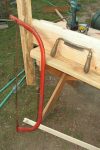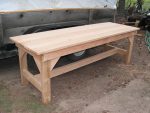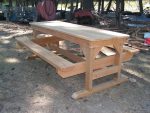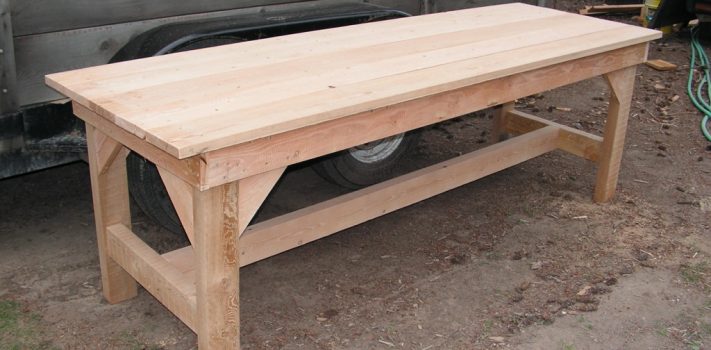Because I only have a small cabin, when doing large-scale canning, I use my outdoor kitchen that includes a deep stainless steel sink. While there is relatively inexpensive used furniture for sale at thrift stores and online places such as Craigslist, most of it does not meet my standards for that which is rugged or sturdy construction and durable when exposed to a long duration of many years exposed to the elements. This means that it is better if we can make our own, especially if we can not purchase it in the future bad times ahead. Furniture can be considered an adjunct necessary for many of our tasks and chores. Without this furniture, the work could not performed as efficiently or at all.
In this article are several photos of furniture that I put together over the past summer. This furniture can be used indoors or outdoors. It is basic and multi-purpose and can be modified to fit the location or the function. Rugged outdoor furniture would be needed for large gatherings such as a barbecue with the neighbors or as workstations. Or it might be needed to establish an outdoor kitchen to avoid heating up the house during the summer.
Good and Cheap
I was very fortunate to have access to scrap lumber from a private mill that produces custom lumber for high-end homes, but I could have recycled used lumber. And in some cases that is what I do. So the cost was limited to three pounds of high-quality Torx-head screws purchased for about $6 per pound. I could have used nails, but screws are at least three times stronger. While the lumber was either full dimensional lumber, it was also oddly sized and therefore ‘scrap’ or ‘seconds’ that would not be marketable to those performing standard or large-scale construction work.
Because of the variations using nonstandard lumber or reclaimed lumber, using it requires additional ingenuity. I work without plans and simply follow my nose after making a rough estimate of what it should be and by inventorying the available material. I can assess how to engineer it or how to assemble it using the available material at hand and begin to ‘create’ it. Most of the wood used here is made the old-fashioned way and is full-dimension. This means a 2″ x 4″ board of rough cut lumber measures 2 inches x 4 inches instead of 1 3/4″ x 3 1/2″ which are the finished dimensions of a modern ‘2×4’ board.
Modern construction-grade lumber is typically made from softer fir and pine woods. I recommend that you specify Douglas Fir wood for structural grade wood. Avoid using ‘white pine’ for anything except decorative uses.
The wood from the local private mill far outclasses the lumber available from a commercial lumber mill in terms of strength and beauty. It is made from locally sourced Douglas Fir and Larch trees from private property. But some of it can also be Birch and Spruce, as well as others. There is a lot of diversity or tree species in my region. The following photo shows the grain of the wood used that will help the reader identify Western Larch (a.k.a. Tamarack) that is very close to what is considered a hardwood. Larch is a dense or heavy wood that is ideal for furniture and also for woodstove burning. It has needles so it resembles a pine tree. But it is not an evergreen. Rather, it is a deciduous tree that loses its needles each fall.
The more dense the wood, the more British Thermal Units (BTUs) of heat it can produce. If you are in the Inland Northwest and buy cordwood for heating, then find a supplier that has Larch for sale. By the way, the building in the background of these photos was constructed from lumber produced by a private mill back in the 1940s. It does not have a solid foundation, yet it is not only still standing, it is safe to use. It too is an example of the kind of construction that will be needed in the future bad times ahead.
Tools and Fasteners
The only tools needed were a stubby lead pencil, a retractable tape measure, an inexpensive skilsaw, a speed square, and a cordless drill. Construction time was a few hours to most of one day for the larger pieces. This includes finely sanding and prepping a finish, either in an oil or a marine grade polyurethane.
If I had used traditional tools such as a hand saw and a hammer, construction time would have been several hours longer for the larger pieces, and an hour or two for the smaller tables. Sawing with a handsaw is much harder work and requires much more time to cut. The process of sawing by hand can be accelerated by using a D saw or buck saw that uses a Type-51 blade that is designed to cut dry soft woods. The cuts are not as precise as a traditional carpenter’s hand saw that has finer cutting teeth, yet it cuts surprisingly well and much faster, and the edge of the cut is good enough for this type of furniture.
To lower the cost, instead of construction grade screws I would choose galvanized nails as the lower tech and lower cost fasteners. Ring-tailed nails will rust and they are harder to hammer in straight in harder wood such as Larch or Douglas Fir. Galvanized nails will not rust as quickly as standard steel nails, and because of the texture on the surface, galvanized nails hold better than standard nails. This type of nail holds wood together best over the long term. One must however possess the skill to swing a hammer effectively. In this day and age, swinging a hammer is a lost art. And this makes it possible to pick up large containers of nails at garage sales very inexpensively as fewer people still know how to swing a hammer. Once so skilled, someone can drive a nail to a board just as quick or even quicker than one can screw a screw into the same wood.
Knowing how to work efficiently with a hammer and nails means we can offset the longer time it takes to saw by hand, and therefore the overall construction time is reduced and closer in measure to that of modern construction methods. I can pound nails three times faster than I can put screws into a board. Yet I will need 3 times as many nails to equal the strength of one modern Torx head construction grade screw.
If someone lacks any of the aforementioned tools or fasteners, then there are substitute means and methods to shape and secure wood together. Given more time, joinery can be done with only hand-operated tools, such as a drill, a saw, and a hatchet. For example, if I lacked a tape measure, then a piece of string can be a practical substitute. With a hand drill and bits, dowels can be driven in, to secure two pieces of wood. With a chisel or even a hatchet, one can hand-mortise joints. This of course takes more time and more skill than using modern mass-produced metal fasteners.
Handsaws
These old-fashioned tools and techniques require much more skill and construction time, therefore it is best to stock up on modern materials and tools like a hammer and nails, and files that can sharpen hand saws. Be sure to learn how to sharpen saws from a one or two-man cross-cut saw to the typical carpenter’s saw. The same technique used for large cross-cut saws are used to sharpen the typical D saw or bucksaw blade. The same type of blade is found in all sizes. I have saws in all sizes from 8 feet long to only just foot long.
 A 3-foot long D saw (also known as a Swedish saw) is the best compromise saw for most rough carpentry work. It makes it possible for a man to cut faster, because he can use the full length of his arm for each stroke and all the momentum his body can provide. Measure from the wrist to the shoulder to determine the length of the saw blade that is closest to the length of your arms and a saw that will be the most efficient in your hands. However, there are other considerations. My 40-inch D saw is very fast as two hands can be used. Saw utility is also about body mechanics.
A 3-foot long D saw (also known as a Swedish saw) is the best compromise saw for most rough carpentry work. It makes it possible for a man to cut faster, because he can use the full length of his arm for each stroke and all the momentum his body can provide. Measure from the wrist to the shoulder to determine the length of the saw blade that is closest to the length of your arms and a saw that will be the most efficient in your hands. However, there are other considerations. My 40-inch D saw is very fast as two hands can be used. Saw utility is also about body mechanics.
The same can be said for swinging an axe or maul with the greatest amount of power and landing the strike where it is most likely to cause a split or for a larger chunk to be removed. It takes practice to learn how to work a saw efficiently or with less effort. It is a learned skill that does not require more muscle, but rather economy of motion. Each saw from 20 to 40 inches in length has its best application. The greater in length that a D saw is, the thicker in diameter log or beam that can be cut.
A sharp blade cuts surprisingly fast. Replacement D saw blades can be purchased in bulk. Even if the saw frame wears out, a wooden buck saw is easy to construct and can use those same saw blades. The heavy wooden bucksaw applies additional downward pressure and may require more effort, but the cutting can be faster, as well.
Furniture Designs With Descriptions
Tables #1 to #4 are good all-around designs that can be modified. They are similar yet differ in one important way that makes them more or less adaptable given the user’s needs or preferences. The width and length is determined by the available material and by the builder’s needs. As shown here, these tables generally measure 28 to 32 inches wide, 28 to 32 inches in height and 6 to 8 feet long. Lower height tables are better for larger projects and higher tables are better for fine work. Fit the table to the users and to the type of work, and it will be a better-designed table. The picnic table described is a design that is an attempt to fit all people well. This one does, but most are awkward in some way. Engineering is typically an exercise in compromises. The fewer the compromises the better the product will fit a specialized task.
Table Project #1

 The photo at left shows a very sturdy table that can be used for a wide variety of purposes from the kitchen, to the garage and it can be the basis of other styles of tables should the need arise. So it is not only a good general-purpose design as pictured, but it can also be easily modified. That is seen in the photo at right which shows this same table transformed into a picnic-style table.
The photo at left shows a very sturdy table that can be used for a wide variety of purposes from the kitchen, to the garage and it can be the basis of other styles of tables should the need arise. So it is not only a good general-purpose design as pictured, but it can also be easily modified. That is seen in the photo at right which shows this same table transformed into a picnic-style table.
(To be concluded tomorrow, in Part 2.)










